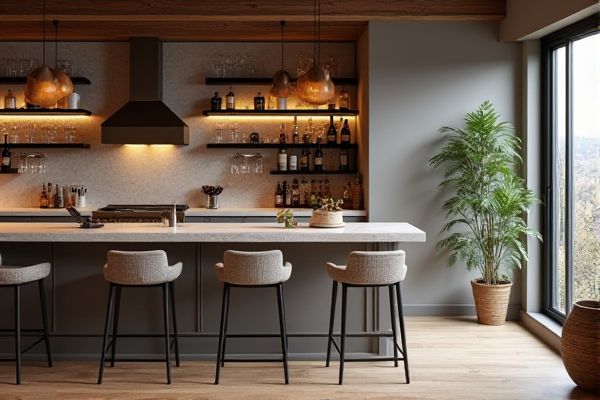
Bar stools are typically taller, designed for bar-height counters around 40-42 inches, while counter stools suit standard kitchen counters about 34-36 inches high, ensuring comfortable seating based on your space. Explore the rest of the article to find the perfect stool height and style for Your home or commercial space.
Table of Comparison
| Feature | Bar Stool | Counter Stool |
|---|---|---|
| Height | 28-30 inches | 24-26 inches |
| Use | Bar counters (typically 40-42 inches high) | Kitchen counters (typically 34-36 inches high) |
| Comfort | May include footrests and back support | Often designed for casual seating with footrests |
| Design | Varies from simple to elaborate | Generally simpler, suited for everyday use |
| Common Materials | Wood, metal, plastic, upholstered | Wood, metal, plastic, cushioned seats |
Introduction to Bar Stools and Counter Stools
Bar stools typically measure 28 to 32 inches in height, designed for standard bar counters around 40 to 42 inches tall, offering elevated seating suitable for social or casual dining settings. Counter stools range from 24 to 27 inches high, fitting kitchen islands or counters approximately 34 to 36 inches in height, providing comfortable seating for meal preparation or casual dining. Your choice between bar stools and counter stools should consider the height of your counter or bar to ensure ergonomic comfort and style.
Defining Bar Stools: Key Features
Bar stools typically feature a seat height ranging from 28 to 33 inches, designed for use at standard bar heights of 40 to 42 inches. They often include footrests and may have backs or armrests for added comfort during extended seating. Understanding these key features helps you choose the right stool for your space, ensuring proper height and ergonomic support.
Understanding Counter Stools: Distinct Characteristics
Counter stools are typically 24 to 27 inches in height, designed specifically for kitchen counters or islands that are about 36 inches tall. Their comfortable seat height allows Your legs to rest naturally under the counter, making them ideal for casual dining or food preparation areas. Unlike bar stools, which are taller and suited for bar-height surfaces, counter stools provide better ergonomics for standard kitchen counters.
Height Differences: Bar Stool vs Counter Stool
Bar stools typically have a seat height ranging from 28 to 32 inches, designed for use with bar-height counters that stand around 40 to 42 inches tall. Counter stools are shorter, with seat heights between 24 to 27 inches, making them ideal for standard kitchen counters that measure 34 to 36 inches in height. Choosing the correct height ensures your comfort and aligns with your counter or bar height for ergonomic seating.
Ideal Uses and Placement in the Home
Bar stools, typically 28 to 32 inches high, are ideal for kitchen islands and home bars where higher seating is needed for casual dining or entertaining. Counter stools, measuring 24 to 27 inches in height, fit perfectly at kitchen counters or islands with standard counter height, facilitating comfortable seating for meal prep or quick snacks. Selecting the appropriate stool height ensures optimal comfort and functionality in spaces like breakfast nooks, outdoor patios, or game rooms.
Design and Style Considerations
Bar stools typically feature seats ranging from 28 to 32 inches in height, designed for use with standard bar counters, and often include footrests, swivel options, and back support to enhance comfort and style. Counter stools are generally shorter, with seat heights between 24 to 27 inches, tailored for kitchen islands or counters and available in various designs such as backless, cushioned, or with armrests to fit different aesthetics. Both stool types offer diverse materials and finishes, including wood, metal, and upholstery, allowing customization to match modern, rustic, or industrial interior styles.
Comfort and Ergonomics Comparison
Bar stools typically stand 28-30 inches high, designed for bar-height counters, offering elevated seating that may require footrests for added comfort and support. Counter stools, generally 24-26 inches in height, align with standard kitchen counters, promoting better posture by allowing feet to rest naturally on the floor or a lower rung. Ergonomically, counter stools reduce strain on the lower back and legs during extended sitting, making them more suitable for casual dining or workspaces where comfort is prioritized.
Choosing the Right Stool for Your Space
Bar stools typically measure 28-30 inches in seat height, making them ideal for standard bar counters, while counter stools range from 24-27 inches, suited for kitchen islands or lower counters. Selecting the right stool height ensures comfortable seating and proper legroom, preventing strain during use. Consider the stool's design, swivel capability, and backrest options to complement the space's functionality and aesthetic.
Material and Durability Factors
Bar stools typically feature sturdy materials like hardwood, metal, or durable plastic to withstand frequent use and weight variations, while counter stools often prioritize lighter materials such as plywood or aluminum for easier mobility. Your choice should consider the finish quality, weather resistance, and frame stability to ensure long-lasting durability, especially in high-traffic or outdoor settings. Upholstered cushions and reinforced joints enhance comfort and structural integrity, making them vital material factors in both bar and counter stools.
Bar Stools vs Counter Stools: Which Is Right for You?
Bar stools typically have a seat height of 28 to 32 inches, designed for bar-height counters around 40 to 42 inches tall, while counter stools measure 24 to 27 inches tall, fitting counters or islands approximately 34 to 36 inches in height. Choosing between bar stools and counter stools depends on the height of your seating surface, ensuring comfort and proper posture during use. Your decision should prioritize stool height alignment with your countertop to enhance functionality and style in your space.
 homyna.com
homyna.com